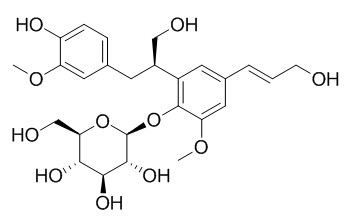Icariside E5
Icariside E5 may have antioxidant property that strengthen the importance of peppers in the Mediterranean diet.
Inquire / Order:
manager@chemfaces.com
Technical Inquiries:
service@chemfaces.com
Tel:
+86-27-84237783
Fax:
+86-27-84254680
Address:
1 Building, No. 83, CheCheng Rd., Wuhan Economic and Technological Development Zone, Wuhan, Hubei 430056, PRC
Providing storage is as stated on the product vial and the vial is kept tightly sealed, the product can be stored for up to
24 months(2-8C).
Wherever possible, you should prepare and use solutions on the same day. However, if you need to make up stock solutions in advance, we recommend that you store the solution as aliquots in tightly sealed vials at -20C. Generally, these will be useable for up to two weeks. Before use, and prior to opening the vial we recommend that you allow your product to equilibrate to room temperature for at least 1 hour.
Need more advice on solubility, usage and handling? Please email to: service@chemfaces.com
The packaging of the product may have turned upside down during transportation, resulting in the natural compounds adhering to the neck or cap of the vial. take the vial out of its packaging and gently shake to let the compounds fall to the bottom of the vial. for liquid products, centrifuge at 200-500 RPM to gather the liquid at the bottom of the vial. try to avoid loss or contamination during handling.
Current Analytical Chemistry2024, 20(8):599-610.
The Journal of Phytopharmacology2020, 9(1): 1-4
Biomed Chromatogr.2019, 8:e4774
J AOAC Int.2024, qsae028.
Res Pharm Sci.2023, 18(3):244-261.
Int J Mol Med.2019, 43(6):2516-2522
ACS Pharmacol. Transl. Sci.2023, 3c00129.
Appl. Sci.2021, 11(1),14.
Evid Based Complement Alternat Med.2016, 2016:1230294
Front Pharmacol.2021, 12:744624.
Related and Featured Products
J Agric Food Chem. 2001 Apr;49(4):2022-9.
New glycosides from Capsicum annuum L. var. acuminatum. Isolation, structure determination, and biological activity.[Pubmed:
11308362]
Investigation of polar extracts from ripe fruits of Capsicum annuum L. var. acuminatum yielded three new glycosides, capsosides A (1) and B (2) and capsianoside VII (3), along with seven known compounds (4-10).
METHODS AND RESULTS:
The chemical structures were elucidated mainly by extensive nuclear magnetic resonance methods and mass spectrometry, and the biological activities of icariside E(5) (4) were tested by different assays. Icariside E(5), in contrast to capsaicin, neither induces an increase in the intracellular levels of reactive oxygen species nor affects the mitochondria permeability transition, and it does not signal through the vanilloid receptor type 1. Interestingly, this compound protects Jurkat cells from apoptosis induced by the oxidative stress mediated by serum withdrawal.
CONCLUSIONS:
These results suggest that icariside E(5) may have antioxidant properties that strengthen the importance of peppers in the Mediterranean diet.
Biochemical Systematics and Ecology,2008,36(12): 915–918.
Flavonoid glycosides and phenolic acids from Ehretia thyrsiflora[Reference:
WebLink]
METHODS AND RESULTS:
Twelve compounds including six flavonoids and six phenolic acids, isoquercetrin, hyperoside, trifolin, astragalin, kaempferol 3-O-arabinosylgalactoside, quercetin 3-O-arabinosylgalactoside, rosmarinic acid, cinnamic acid, Icariside E5, ferulic acid, α-hydroxydihydrocaffeic acid, lithospermic acid B were first isolated from this species.
CONCLUSIONS:
The considerable phenolic compounds existed in this species have important systematic significance in the argument of the family the Boraginaceae.



